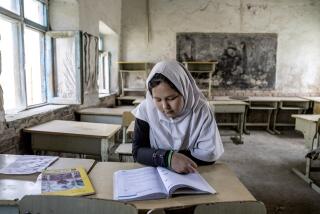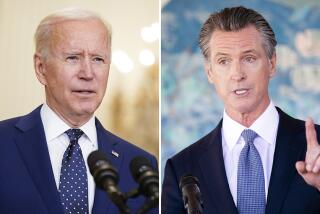20 years later, still quaking
The wind, the calendar and the drumbeat of earthquake anniversary stories have me on edge this week.
I’m back to sleeping with a flashlight at hand, a pair of shoes next to the bed and a wad of cash tucked away. The gusts of wind that roar through the canyon and rattle my windows trigger long-buried flashbacks of terror.
It’s been 20 years since the Northridge earthquake jolted my block in Northridge.
Official reports say the 6.7 temblor lasted less than 20 seconds. But ask anyone in my neighborhood and they’ll tell you that must be wrong. Our earthquake, and its aftershocks, went on for days, weeks, months.
I enjoy the recollecting now as much as anyone. It’s history; recovery has put that ordeal behind us. But I’m still freighted with memories that make me anxious from time to time.
What I remember most is how small and helpless I felt. I’d been widowed a few weeks before; crisis management had always been my husband’s job.
So there I was at 4:30 in the morning, tossed from my bed, crawling through darkness with a frightened 3-year-old under my arm, as the house shook furiously and her sisters wailed from their room at the end of the hall.
We all braced ourselves in a bedroom doorway, as we had been taught. We bounced against the doorjamb so hard with each jolt, we’d have bruises later on.
“Don’t worry!” I kept shouting, over the sound of breaking glass and unseen explosions. “It’s just an earthquake. It’s just an earthquake.”
As if naming the terror would prove that I was in control.
::
I have to admit that I wasn’t as prepared as I should have been. I had flashlights, but no batteries. I had a car, but the gas tank was empty; I’d intended to fill it that morning. I had only $6 in the house, in a neighborhood where cash-dispensing ATMs were suddenly powerless.
But I had something that made my failures matter less. I was surrounded by good neighbors.
I herded my shivering children inside our neighbors’ SUV, then the grown-ups huddled on the lawn and watched the news on a battery-operated TV. The neighbors gave us water from their pool to flush our toilets. I gave them bread to go with their peanut butter. We took turns dashing inside between aftershocks to get blankets, shoes and jackets.
My block wasn’t the only place where teamwork mattered. In communities all across the city people came together, feeding, comforting, sheltering and commiserating with one another.
The rebuilding, too, was a textbook example of cooperation. Federal, state and local authorities worked together to keep recovery on track. As our story of the earthquake’s 10-year anniversary in 2004 recounts, great public works projects were accomplished with extraordinary energy. The collapsed Santa Monica Freeway was rebuilt and reopened within five months. Public buildings, shopping malls, schools and colleges were restored or improved in a massive campaign that turned the Valley into a giant construction site.
It was the most expensive natural disaster the nation had ever experienced. The earthquake may not have been the largest in measured magnitude, but it produced the strongest ground motion ever recorded by an urban quake in North America.
Earthquake experts say it was just a preview of temblors to come. An analysis by state and federal scientists estimates that Southern California has a 97% chance of being hit in the next 30 years by an earthquake larger than the Northridge quake of 1994.
We were fortunate 20 years ago that the death toll wasn’t higher, the damage more extreme. We’ll be better prepared next time and won’t rely so much on luck, city officials promise.
::
Now, the City Council is considering seismic safety initiatives, including investigating potentially dangerous buildings, constructed like the apartment complex that collapsed in the Northridge quake, killing 16 people.
And Mayor Eric Garcetti announced this week that an earthquake expert will spend the next year surveying buildings and meeting with residents, business owners, developers and other scientists to come up with policies that make the city more earthquake-proof.
From where I stand, on once-shaky ground, that’s a very good idea. I’d like to add “block parties” to the list of earthquake survival tools. Get to know your neighbors, if you don’t already; you never know when you’ll need them.
Twelve hours after the earthquake, as daylight faded, we were still gathered on the front lawn. A man I didn’t know, from the other end of the block, came down and offered to lend me a giant industrial flashlight.
I never gave it back, and for years I felt bad about that.
I don’t anymore. The flashlight stopped working years ago, but I still keep it around. It reminds me of how vulnerable I felt that day -- and how I relied for sustenance on friends, neighbors and strangers.
It’s a symbol to me of the importance of caring for one another. Because that -- not just bottled water, canned food or plastic bags -- is what helped my shell-shocked family to survive.
Now I keep that broken flashlight in a closet near the door. Right next to a duffel bag stuffed with earthquake survival supplies.
--
Twitter: @SandyBanksLAT
More to Read
Start your day right
Sign up for Essential California for news, features and recommendations from the L.A. Times and beyond in your inbox six days a week.
You may occasionally receive promotional content from the Los Angeles Times.






